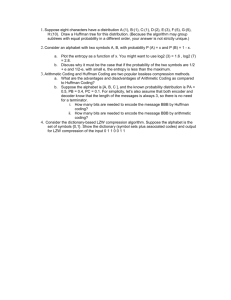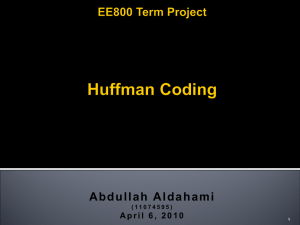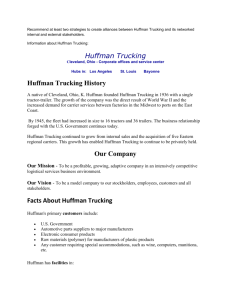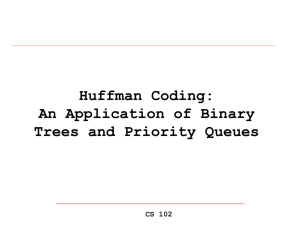Lecture 6: Scalar Quantization
advertisement
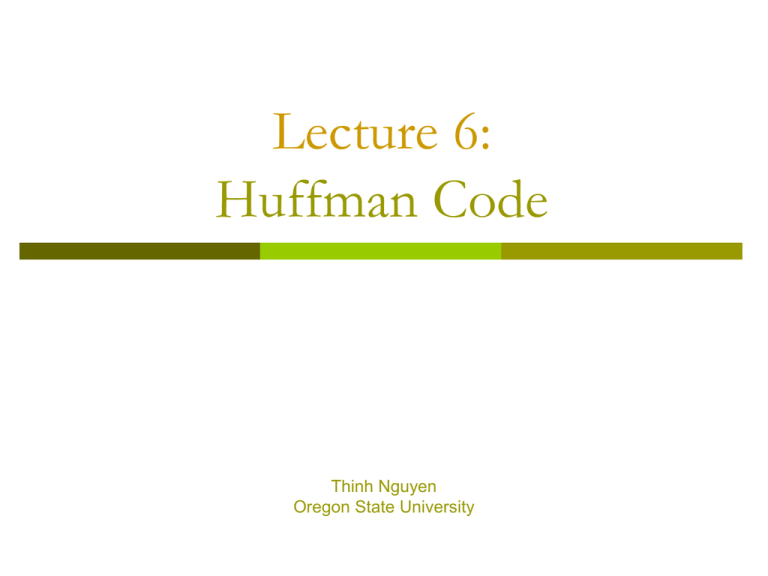
Lecture 6:
Huffman Code
Thinh Nguyen
Oregon State University
Review
Coding: Assigning binary codewords to
(blocks of) source symbols.
Variable-length codes (VLC)
Tree codes (prefix code) are instantaneous.
Example of VLC
Creating a Code: The Data Compression
Problem
Assume a source with an alphabet A and known
symbol probabilities {pi}.
Goal: Chose the codeword lengths as to minimize
the bitrate, i.e., the average number of bits per
symbol li * pi.
Trivial solution: li = 0 * i.
Restriction: We want an decodable code, so
-l
2 i <=1 (Kraft inequality) must be valid.
Solution (at least in theory): li = – log pi
In practice…
Use some nice algorithm to find the codes
Huffman coding
Tunnstall coding
Golomb coding
Huffman Average Code Length
Input: Probabilities p1, p2, ... , pm for symbols a1, a2, ... ,am,
respectively.
Output: A tree that minimizes the average number of bits
(bit rate) to code a symbol. That is, minimizes
m
l p i li
i 1
Where li is the length of codeword ai
Huffman Coding
Two-step algorithm:
Iterate:
1.
–
–
Merge the least probable symbols.
Sort.
Assign bits.
2.
a
b
c
d
0
10
110
111
0
0.5
0.5
10
0.25
0.25
11
0.125
0.125
0.25
0
1
0.5
Merge
0.5
Sort
Assign
Get code
More Examples of Huffman Code
More Examples of Huffman Code
More Examples of Huffman Code
More Examples of Huffman Code
Average Huffman Code Length
Optimality of A Prefix Code
Necessary conditions for an optimal variable-length binary
code:
1.
Given any two letters aj and ak, if P(aj) >= P(ak) , then lj <= lk,
where lj is the length of the codeword aj.
2.
The two least probable letters have codewords with the same
maximum length lm.
3.
In the tree corresponding to the optimum code, there must be
two branches stemming from each intermediate node.
4.
Suppose we change an intermediate node into a leaf node by
combining all the leaves descending from it into a composite
word of a reduced alphabet. Then if the original tree was
optimal for the original alphabet, the reduced tree is optimal for
the reduced alphabet.
Condition 1: If P(a ) >= P(a ) , then l <= l , where l is the
j
k
j
k
j
length of the codeword aj.
Easy to see why?
Proof by contradiction:
Suppose a code X is optimal with P(aj) >= P(ak), but lj > lk
By simply exchanging aj and ak, we have a new code Y in which,
its average length
= lipi is smaller than that of code X.
Hence, the contradition is reached. Thus, condition must hold
Condition 2: The two least probable letters have codewords with
the same maximum length lm.
Easy to see why?
Proof by contradiction:
Suppose we have an optimal code X in which, two codewords with lowest
probabilities ci and cj and that ci is longer than cj by k bits.
Then because this is a prefix code, cj cannot be the prefix to cj. So, we
can drop the last k bits of ci.
We also guarantee that by dropping the last k bits of ci, we still have a
decodable codeword. This is because ci and cj have the longest length
(least probable codes), hence they cannot be the prefix of any other
code.
By dropping the k bits of ci , we create a new code Y which has shorter
average length, hence contradiction is reached.
Condition 3: In the tree corresponding to the optimum code,
there must be two branches stemming from each intermediate
node..
Easy to see why?
If there were any intermediate node with only one branch
coming from that node, we could remove it without affecting the
decodability of the code while reducing its average length.
0
0
1
a
0
c
b
a: 000
b: 001
c: 1
1
0
1
0
0
c
1
a
b
a: 00
b: 01
c: 1
Condition 4:
Suppose we change an intermediate node into a leaf node by combining
all the leaves descending from it into a composite word of a reduced
alphabet. Then if the orginal tree was optimal for the original alphabet,
the reduced tree is optimal for the reduced alphabet.
1
0
0
0
1
1
a
b
c
0
d
e
a: 000
e: 00
b: 001
c: 01
c: 01
d:1
d:1
1
0
1
c
d
Huffman code satisfies all four conditions
Lower probable symbols are at longer depth of the tree
(condition 1).
Two lowest probable symbols have equal length (condition
2).
Tree has two branches (condition 3).
Code for the reduced alphabet needs to be optimum for the
code of the original alphabet to be optimum by construction
(condition 4)
Optimal Code Length (Huffman Code
Length)
H (S ) l H (S ) 1
l : Average length of an optimal code
m
H ( S ) P(ai ) log 2 P(a)i : Entropy of the source
i 1
Proof:
Extended Huffman Code
A {a1, a2 ,...am }, A {a1a1...a1 , a1a1...a2 ,..., am am ...am }
n
n times
mn symbols in the A n alphabet
H (S ) l H (S ) 1 / n
l : Average length of Huffman Code
H ( S ) : Entropy of the source
Proof: page 53 of the book
Huffman Coding: Pros and Cons
+ Fast implementations.
+ Error resilient: resynchronizes in ~ l2 steps.
-
The code tree grows exponentially when the source is
extended.
-
The symbol probabilities are built-in in the code.
Hard to use Huffman coding for extended sources / large
alphabets or when the symbol probabilities are varying by
time.
Huffman Coding of 16-bit CD-quality
audio
Filename
Original file
size (bytes)
Entropy (bits)
Compressed
File Size
(bytes)
Compression
Ratio
Mozart
symphony
939,862
12.8
725,420
1.30
Folk rock
(Cohn)
402,442
13.8
349,300
1.15
Huffman coding of the Differences
Filename
Original file
size (bytes)
Entropy (bits)
Compressed
File Size
(bytes)
Compression
Ratio
Mozart
symphony
939,862
9.7
569,792
1.65
Folk rock
(Cohn)
402,442
10.4
261,590
1.54
Complexity of Huffman Code
O(n log(n))
Log(n) is the depth of the tree and n operation to
compare for the lowest probabilities.
Notes on Huffman Code
Frequencies computed for each input
Fixed Huffman tree designed from training data
Must transmit the Huffman code or frequencies as well
as the compressed input.
Requires two passes
Do not have to transmit the Huffman tree because it is
known to the decoder.
H.263 video coder
3. Adaptive Huffman code
One pass
Huffman tree changes as frequencies change
